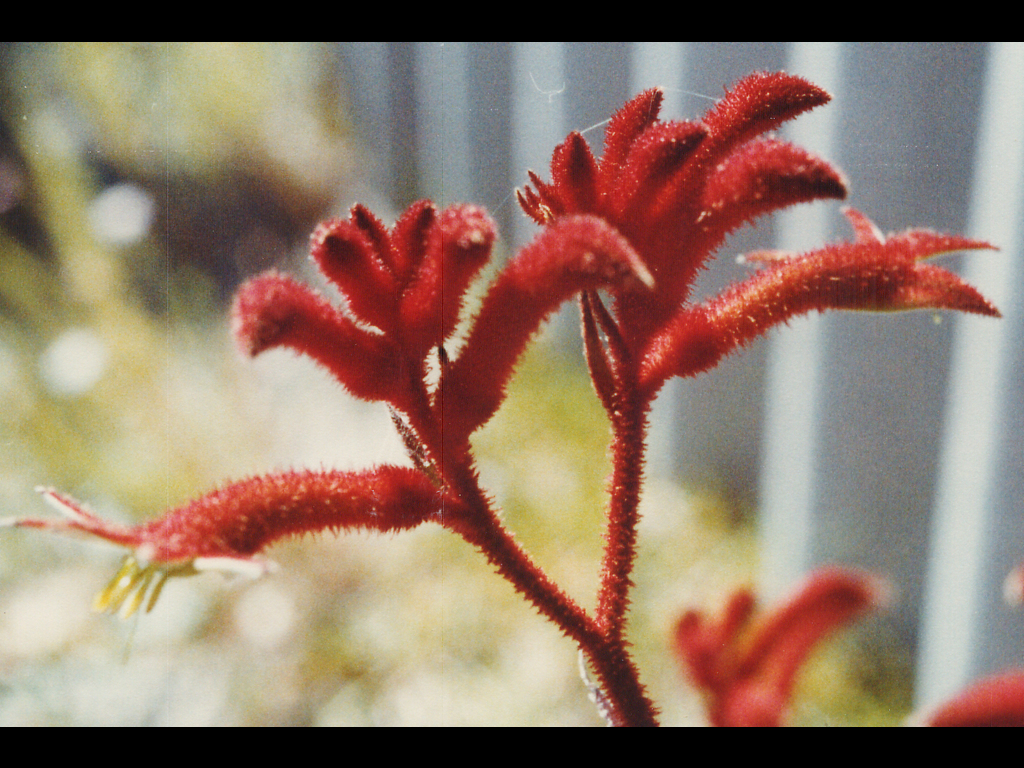Anigozanthos 'Little Jewel'
- File Number
- 222
- ACRA Field Book Number
- 24
- Registration Date
- 08/10/1991
- Application Received
- 01/09/1980
- Family
- Haemodoraceae
- Cultivar Name
- Anigozanthos 'Little Jewel'
- Origin
- Anigozanthos 'Little Jewel' is the result of a manipulated cross between A. onycis and A.flavidus. The cross was performed by Mr K R Oliver of Western Australia. This cultivar was first received by the Authority in September 1980. Registration applied for by Mr K R Oliver of Western Australia.
- Characteristics
- This cultivar has branched inflorescences to 0.4m tall with scattered red plumose hairs increasing on the upper half. The flowers are in a simple terminal raceme with pedicles to about 7mm long. They are covered with dense plumose hairs which are dense on the ovary and upper side and a green- yellow on the lower side. The perianth tube is about 45mm long subtended by a swollen ovary. The tube is glabrous on the inside above the middle with scattered orange plumose hairs below. The perianth lobes are about 10mm long with the lower ones dividing more deeply. The lobes are covered with green-yellow plumose hairs on the inside. The anthers are bright yellow on green-yellow slightly shorter filaments, the connective tipped with a glandlike appendage. The ovules are more than 12 per locule. Diagnosis: A. onycis Origin W.A., Height 0.1m, Width 0.3-0.5m, Flowering Aug-Nov, Leaves 2-10cm, glabrous deciduous, Flower stems 15-30cm branched, woolly hairs, Flowers Tubular 5cm racemes of 5-9 flowers, woolly hairs, lobes spreading pale green to red, Cultivation Well drained light to medium soils, partial or full sun. Propagation Seed or division A. 'Little Jewel’ Origin Cultivated hybrid, Height 0.2m, Width ?, Flowering Sept-Oct in W.A., Leaves Glossy green Flower stems 0.4m red plumose, Flowers Branched stems, simple terminal raceme, pedicels 7mm long, dense plumose hairs, red on ovary and upper side, green-yellow below. Cultivation Semi drought-hardy, least susceptible to ink disease, Propagation Vegetative means A. flavidus Origin W.A.Height 1m Width 1m Flowering Oct-Feb Leaves Glabrous Flower stems 2m smooth, branched Flowers Tubular 3-4cm Hairy lobes not turned, back yellow-green,red, pink, yellow, green. Cultivation Common, wide range of soils and climates. Moist, light to medium soil, partial or full sun. May be dam- aged by frost.Propagation Seed or division
- Cultivation
- This cultivar is one of the least susceptible to ink disease and is semi- hardy to drought. It flowers from September to October in W.A. Cultivated since 1972. This cultivar must be propagated by tissue culture or other forms of vegetative propagation to retain the cultivar form.
- Publication
- Australian Cultivar Registration Authority (1991), Some Kangaroo Paw Cultivars (continued from 16(126)). Australian Plants 16(127): 135
- Colour Coding
- RHS Colour Chart 1966Plumose hairs (ovary): near Red Group 46BPerianth tube: Green Group 138Filaments: Yellow-green Group145AAnthers: near Yellow-orange Group 17C
- Propagation
- Division or tissue culture
- Applicant Name
- K R Oliver
- Uses
- As part of a mass planting or mixed in a shrubbery, or as a spectacular feature plant. Attracts nectar feeding birds.
- Availability
- Unknown
- ANBG Accession Numbers
- ACC222
- NSL ID
- -

